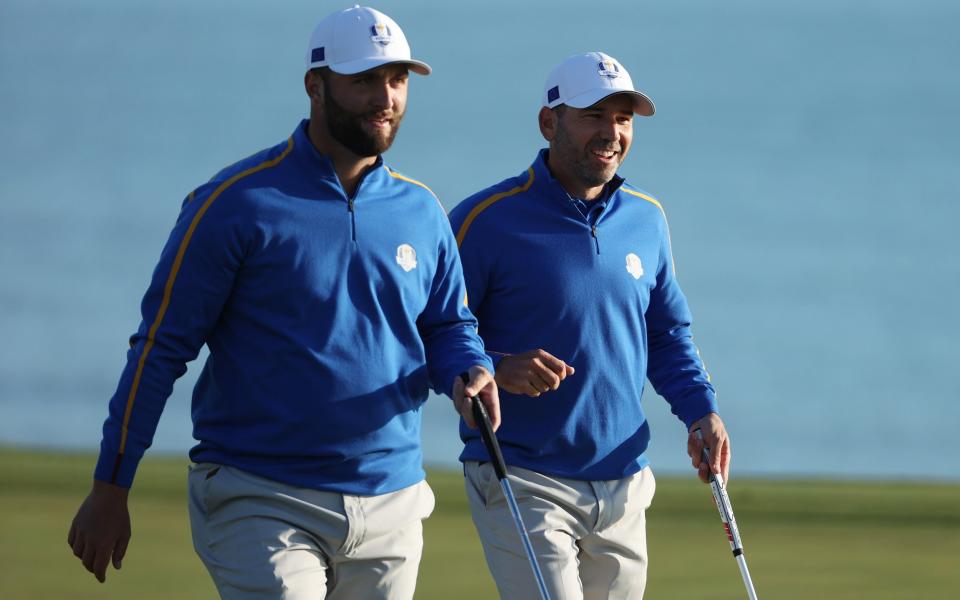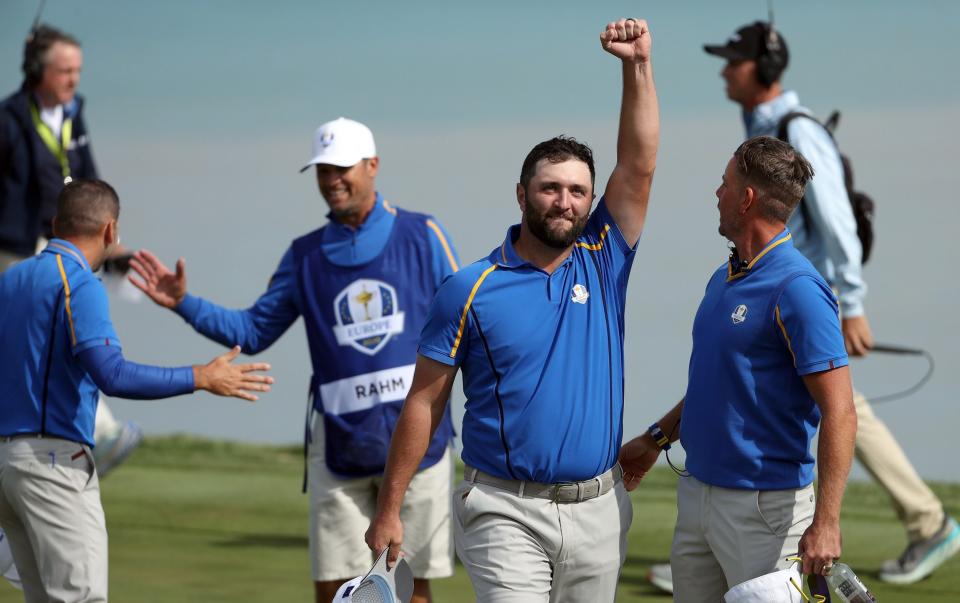Europe's new 'Spanish Armada' Garcia and Rahm fired up by opponents' refusal to concede putt

Sometimes, matchplay isn’t so much about knowing how to hit a putt as when to concede one. This was the moral of the Ryder Cup’s opening match, which saw the Spanish duo of Jon Rahm and Sergio Garcia become inspired after a backfiring instance of American “mind games”.
On the sixth hole Jordan Spieth and Justin Thomas declined to give the Europeans the benefit of the doubt on an 18-inch tiddler. The only result was to fire up the Spanish engine, which kicked in with match-turning birdies on the next two holes.
The putt in question was so short that everyone around the green had already turned away and begun the march to the seventh tee. When the gallery realised that it was not going to be given, they let out an exhalation of surprise, building into a delighted “Ooooo”.
After a short moment of apparent disbelief, Garcia stepped up and popped the ball in the hole, and Rahm then seemed to have something to say as the players walked off. On the bridge overlooking the hole, European captain Padraig Harrington seemed unamused. But this was a matter of etiquette rather than true sporting concern, as Harrington and everyone else knew that Garcia could scarcely miss.
“It's all part of the Ryder Cup, right?” said Rahm after the Spanish pair had concluded a 3&1 victory. “It's a lot of times where people are going to try to play mind games. In my case, [when] I have a foot and a half to tie or win holes, I will make it, honestly. It's always a bonus to see the ball go in the hole, and I feel like it did put a bit of an extra thought in our mind.
“I feel like that's when it got into gear,” added Rahm. “I started really well after that and played nearly flawless golf. It's a lot easier when you have a robot [Garcia] off the tee with the irons, so all I had to do was help him make a few putts and not get in his way.”

The European ship is at its best with a Spanish mainstay. No partnership has ever scored as many Ryder Cup points as Seve Ballesteros and Jose Olazabal, who were virtually unbeatable through the late 1980s and early 1990s. Has Harrington now found a worthy pair of successors?
It was one of the surprises of Paris three years ago that Thomas Bjorn never placed Rahm and Garcia in harness. Admittedly, Rahm was a very different player at the time: a talented but temperamental rookie who had yet to figure out his full potential. But there were a few murmurs about this minor omission, even if Europe’s seven-point winning margin was enough to keep them sotto voce.
Against the intimidating pairing of Spieth and Thomas – the one American team to thrive in 2018 – Rahm and Garcia complemented each other like chinos and moccasins. Or perhaps that should be doublet and hose, given Rahm’s resemblance to a young Henry VIII.
They made six birdies and only a single bogey, relying primarily on Garcia to fire the ball close with his iron play and Rahm to drain a series of putts. Coming in as the only European in the world’s top 10 – or even top 13 – Rahm was under extreme pressure to hold Harrington’s men together, and he handled the situation with a veteran’s aplomb. At just 27, he already feels like a father figure for the team.
Garcia has been at this lark much longer, having turned 41 at the start of the year. In Paris, he had already established himself as the leading points scorer in Ryder Cup history – a tally he has now extended to 26.5. By winning on Friday, he has also matched another record: Nick Faldo’s 23 victories.
In the process, he demonstrated that forty-somethings can do the business this weekend. Should Harrington’s men fail, it will not be because of his experience-heavy selection as much as the power of America’s youth.
As it happens, this was the only foursomes match not to feature one of the home team’s devastating rookies. Spieth and Thomas didn’t play badly, by any means, finishing three under in their own right. And Spieth produced the shot of the morning on the 17th.
Hacking his wedge at a ball stuck waist-high in a vertical bank of vegetation, he threw himself so far off balance that he staggered backwards in the process and careered 25 paces downhill, rushing dangerously past a bunker and almost ending up in Lake Michigan. “Once I started moving,” he said later, “I was like, ‘I've got to keep moving until I find a flat spot.’”
The ball, miraculously, stopped just nine feet from the hole. It was the kind of trick shot you might pull off only a couple of times in a career. Garcia said afterwards that he had applauded Spieth’s wizardry with the 52-degree wedge, before adding that he had been seriously concerned. “I was truly afraid for him because of those wood logs that are there, and it was very close to the wall. So I was hoping that he wouldn't hurt himself, but he hit an unbelievable shot.”
In an anti-climactic finish, Thomas still missed the ensuing putt, thus concluding the contest. It was that sort of frustrating day for this experienced and reliable team. Still, they were realistic afterwards and commended the quality of the Spaniards’ play.
“Sometimes you run into a buzzsaw,” said Spieth. In truth, this particular buzzsaw might never have started if the Americans hadn’t yanked its chain.
Ryder Cup legend Westwood falls just short in brave effort on historic occasion
By James Corrigan
Five years had passed since Lee Westwood last stood on a green in the Ryder Cup and missed that tiddler against Ryan Moore in the Sunday singles for the United States point which ensured defeat for Europe.
And when he pushed a four-footer here on the first in his and Matt Fitzpatrick’s foursomes encounter with Brooks Koepka and rookie Daniel Berger it was all too easy to think that not much had changed in the intervening half decade, especially as the English duo were to run out 2&1 losers.
Yet that lazy verdict would not only be to deny the remarkable resurrection of Westwood, at 48, Europe’s oldest ever player, but also the class of this clash, in which Koepka reminded why he is a four-time major winner.
“We played well enough to win that match,” Westwood said. “They got the breaks; we didn’t. They holed a couple more putts and we didn’t take the chances when we had them. It’s just like that in the Ryder Cup. Sometimes it goes your way and sometimes it doesn’t.”
Of course, Westwood’s detractors would howl at that statement and point out that matchplay is all about who finds the cup at the crucial junctures. It is fair to comment that Westwood’s skew on the first green was a kick in the teeth, if only because they had played the par four so wonderfully to that point.
Westwood drove it 310 yards down the right to give the ideal route to the pin and Fitzpatrick accepted the invitation, spinning in a lob wedge from 61 yards to five feet. Berger missed America’s 15-footer and here was the chance.
It limped rather pitifully to the right, Westwood cast one of those looks that says “how could you?” and so a few US fans saw their cue. “Nicely kept, out Westy!” one yelled, then, on the way to the next tee, another buffoon shouted: “Have you still got the yips, Lee?” Hilarious.

It was a shame because Westwood deserves the utmost respect simply for making it back to this most intense of arenas and so tying Sir Nick Faldo’s record number of appearances for Europe at 11.
Only one player in the 94-year history of the Ryder Cup has ever been older when qualifying by right and not without the need for a wild card – Welshman Dai Rees in 1961 – and no player has ever gone more than 24 years from his first appearance to his last.
By every token, Westwood is a Ryder Cup legend and it would be nice if the Bud Light crew realised so. But idiots will idiotise and, anyway, the home support soon had a positive reason to holler when Koepka enacted a sumptuous pitch from the “native area” below the second green to three feet.
On the next, he converted a 15-footer and it was ominous. But the visitors fought back, squaring it up on the ninth, before the US rattled off back-to-back birdies to grab the advantage they were never to concede. However, Westwood and Fitzpatrick had their chances, failing to make any of a trio of 15-footers or under for birdies on the 10th to the 12th.
“I thought we played great,” Fitzpatrick said. “I think we missed two greens all day. Lee put a bit of an exhibition on tee-to-green, and I didn’t take the chances when I had them.” “Well, we both didn’t,” Westwood said, thinking about his 15-footer on the 17th that would have taken the encounter to the 18th.
“It is a disappointment to allow them to get the half they needed with a bogey. You want to make them earn it, although they did play well.”
This meant that Westwood had lost his past four matches in the Ryder Cup. Naturally, the inclination among many will be to say he has had his day and a changing of the guard is required. But that is not his problem. Westwood is here because he finished in the top nine of Europe’s Ryder Cup standings. He will go again.

 Yahoo Sport
Yahoo Sport 





































